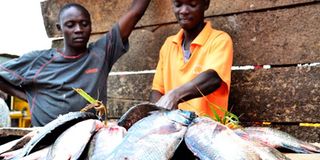Deadly virus attacks tilapia fish

Fish traders selling tilapia fish at one of the shores of Lake Victoria recently. A highly contagious disease is spreading among farmed and wild tilapia, one of the world's most popular fish for human consumption, according to an alert issued by the Food and Agriculture Organisation
What you need to know:
- In 2015, world tilapia production, from both aquaculture and capture, amounted to 6.4 million tonnes, with an estimated value of 9.8 billion US dollars, and worldwide trade was valued at 1.8 billion US dollars.
- China, Indonesia and Egypt are the three leading aquaculture producers of tilapia, a fish deemed to have great potential for expansion in sub-Saharan Africa.
A highly contagious disease is spreading among farmed and wild tilapia, one of the world's most popular fish for human consumption, according to an alert issued by the Food and Agriculture Organisation (FAO).
The alert issued through the Global Information and Early Warnings System indicates that the Tilapia Lake Virus (TiLV) has already been confirmed on three continents: Africa, Asia and the Americas, where countries are being advised to take appropriate risk-management measures to stop the diseases from spreading. Egypt is listed among countries most affected by the outbreak in Africa.
The disease shows highly variable mortality, with outbreaks in Thailand triggering the deaths of up to 90 percent of stocks. Infected fish often show loss of appetite, slow movements, reddened skin, and inflammation of organs including the eyes, brain and liver damage.
"Tilapia producing countries need to be vigilant, and should follow aquatic animal-health code protocols of the World Organisation for Animal Health (OIE) when trading tilapia," the alert reads in part.
Dr Melba Reantaso, a Fishery Resources Officer with FAO says countries need to initiate an active surveillance programme to determine the presence or absence of the virus, the geographic extent of the infection and identify risk factors that may help contain it.
Countries are also encouraged to launch public information campaigns to advise aqua culturists - many of them smallholders - of the virus' clinical signs and the economic and social risks it poses and the need to flag large-scale mortality to bio-security authorities.
It is not currently known whether the disease can be transmitted via frozen tilapia products, but "it is likely that the virus may have a wider distribution than is known today and its threat to tilapia farming at the global level is significant," FAO added in its alert.
Tilapia's are the second most important aquaculture species in volume terms providing food, jobs and domestic and export earnings for millions of people, including many smallholders.
Their affordable price, omnivorous diet, tolerance to high-density farming methods and usually strong resistance to disease makes them an important protein source, especially in developing countries and for poorer consumers.
In 2015, world tilapia production, from both aquaculture and capture, amounted to 6.4 million tonnes, with an estimated value of 9.8 billion US dollars, and worldwide trade was valued at 1.8 billion US dollars. The fish is a mainstay of global food security and nutrition, the Global Information and Early Warnings System said.
China, Indonesia and Egypt are the three leading aquaculture producers of tilapia, a fish deemed to have great potential for expansion in sub-Saharan Africa.




